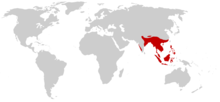
Back ناشر ملك Arabic ملك الكوبرا ARZ ডাঁহী সাপ Assamese Adi kral kobrası Azerbaijani Каралеўская кобра Byelorussian Каралеўская кобра BE-X-OLD Кралска кобра Bulgarian শঙ্খচূড় Bengali/Bangla Cobra reial Catalan Ophiophagus hannah CEB
| King cobra | |
|---|---|

| |
| Scientific classification | |
| Domain: | Eukaryota |
| Kingdom: | Animalia |
| Phylum: | Chordata |
| Class: | Reptilia |
| Order: | Squamata |
| Suborder: | Serpentes |
| Family: | Elapidae |
| Subfamily: | Elapinae |
| Genus: | Ophiophagus Günther, 1864 |
| Species: | O. hannah
|
| Binomial name | |
| Ophiophagus hannah Cantor, 1836
| |

| |
Distribution of the king cobra
| |
| Synonyms | |
|
Genus-level:
| |
The king cobra (Ophiophagus hannah) is a venomous snake endemic to Asia. The sole member of the genus Ophiophagus, it is not taxonomically a true cobra, despite its common name and some resemblance. With an average length of 3.18 to 4 m (10.4 to 13.1 ft) and a record length of 5.85 m (19.2 ft),[2] it is the world's longest venomous snake. The species has diversified colouration across habitats, from black with white stripes to unbroken brownish grey. The king cobra is widely distributed albeit not commonly seen, with a range spanning from the Indian Subcontinent through Southeastern Asia to Southern China. It preys chiefly on other snakes, including those of its own kind. This is the only ophidian that constructs an above-ground nest for its eggs, which are purposefully and meticulously gathered and protected by the female throughout the incubation period.[3]
The threat display of this elapid includes spreading its neck-flap, raising its head upright, making eye contact, puffing, hissing and occasionally charging. Given the size of the snake, it is capable of striking at a considerable range and height, sometimes sustaining a bite. Envenomation from this species is medically significant and may result in a rapid fatality unless antivenom is administered in time. Despite the species' fearsome reputation, aggression toward humans usually only arises from an individual inadvertently exposing itself or being cornered.
Threatened by habitat destruction, it has been listed as Vulnerable on the IUCN Red List since 2010. Regarded as the national reptile of India, it has an eminent position in the mythology and folk traditions of India, Bangladesh, Sri Lanka and Myanmar.
- ^ a b Stuart, B.; Wogan, G.; Grismer, L.; Auliya, M.; Inger, R.F.; Lilley, R.; Chan-Ard, T.; Thy, N.; Nguyen, T.Q.; Srinivasulu, C.; Jelić, D. (2012). "Ophiophagus hannah". IUCN Red List of Threatened Species. 2012: e.T177540A1491874. doi:10.2305/IUCN.UK.2012-1.RLTS.T177540A1491874.en. Retrieved 20 November 2021.
- ^ Cite error: The named reference
mehrtenswas invoked but never defined (see the help page). - ^ Lillywhite, Harvey B. (2014). How Snakes Work: Structure, Function and Behavior of the World's Snakes. New York City: Oxford University Press. p. 241. ISBN 9780195380378.
© MMXXIII Rich X Search. We shall prevail. All rights reserved. Rich X Search
